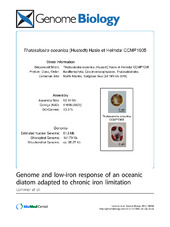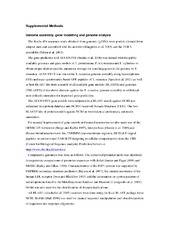| dc.contributor.author | Lommer, Markus | eng |
| dc.contributor.author | Specht, Michael | eng |
| dc.contributor.author | Roy, Alexandra-Sophie | eng |
| dc.contributor.author | Kraemer, Lars | eng |
| dc.contributor.author | Andreson, Reidar | eng |
| dc.contributor.author | Gutowska, Magdalena A. | eng |
| dc.contributor.author | Wolf, Juliane | eng |
| dc.contributor.author | Bergner, Sonja V. | eng |
| dc.contributor.author | Schilhabel, Markus B. | eng |
| dc.contributor.author | Klostermeier, Ulrich C. | eng |
| dc.contributor.author | Beiko, Robert G. | eng |
| dc.contributor.author | Rosenstiel, Philip | eng |
| dc.contributor.author | Hippler, Michael | eng |
| dc.contributor.author | LaRoche, Julie | eng |
| dc.date.accessioned | 2014-10-27T13:44:00Z | |
| dc.date.available | 2014-10-27T13:44:00Z | |
| dc.date.issued | 2012-07-26 | eng |
| dc.identifier.issn | 1465-6914 | en_US |
| dc.identifier.uri | http://hdl.handle.net/1956/8681 | |
| dc.description.abstract | Background: Biogeochemical elemental cycling is driven by primary production of biomass via phototrophic phytoplankton growth, with 40% of marine productivity being assigned to diatoms. Phytoplankton growth is widely limited by the availability of iron, an essential component of the photosynthetic apparatus. The oceanic diatom Thalassiosira oceanica shows a remarkable tolerance to low-iron conditions and was chosen as a model for deciphering the cellular response upon shortage of this essential micronutrient. Results: The combined efforts in genomics, transcriptomics and proteomics reveal an unexpected metabolic flexibility in response to iron availability for T. oceanica CCMP1005. The complex response comprises cellular retrenchment as well as remodeling of bioenergetic pathways, where the abundance of iron-rich photosynthetic proteins is lowered, whereas iron-rich mitochondrial proteins are preserved. As a consequence of iron deprivation, the photosynthetic machinery undergoes a remodeling to adjust the light energy utilization with the overall decrease in photosynthetic electron transfer complexes. Conclusions: Beneficial adaptations to low-iron environments include strategies to lower the cellular iron requirements and to enhance iron uptake. A novel contribution enhancing iron economy of phototrophic growth is observed with the iron-regulated substitution of three metal-containing fructose-bisphosphate aldolases involved in metabolic conversion of carbohydrates for enzymes that do not contain metals. Further, our data identify candidate components of a high-affinity iron-uptake system, with several of the involved genes and domains originating from duplication events. A high genomic plasticity, as seen from the fraction of genes acquired through horizontal gene transfer, provides the platform for these complex adaptations to a low-iron world. | en_US |
| dc.language.iso | eng | eng |
| dc.publisher | BioMed Central | en_US |
| dc.rights | Attribution CC BY | eng |
| dc.rights.uri | http://creativecommons.org/licenses/by/2.0 | eng |
| dc.title | Genome and low-iron response of an oceanic diatom adapted to chronic iron limitation | en_US |
| dc.type | Peer reviewed | |
| dc.type | Journal article | |
| dc.date.updated | 2013-08-23T09:11:59Z | |
| dc.description.version | Peer Reviewed | |
| dc.description.version | publishedVersion | en_US |
| dc.rights.holder | Markus Lommer et al.; licensee BioMed Central Ltd. | en_US |
| dc.rights.holder | Copyright 2012 Lommer et al.; licensee BioMed Central Ltd | en_US |
| dc.source.articlenumber | R66 | |
| dc.identifier.doi | https://doi.org/10.1186/gb-2012-13-7-r66 | |
| dc.identifier.cristin | 1040668 | |
| dc.source.journal | Genome Biology | |
| dc.source.40 | 13 | |


